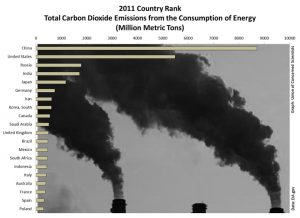ALESSANDRA FERRANTE – When it comes to earths climate, the point of no return might have just been reached.[1] Many scientists are making such grim speculations due to the global concentration of carbon dioxide (CO2) in the atmosphere has reached 400 parts per million (ppm), for the first time in recorded history.[2] Carbon dioxide is considered the “primary driver” of recent climate change therefore, concentrations of this magnitude are historical and bleak.[3]
Since scientists have been measuring levels of carbon dioxide there has been a consensus that once 400ppm is reached it will be almost impossible to reverse the warming effects of the carbon dioxide molecule in the atmosphere. Suggesting, that rising above 400ppm makes it even harder to prevent global temperatures from rising beyond the goal of two degrees Celsius, as agreed upon in the 2015 Paris Climate Conference. [4] A Nasa climatologist stated that the levels of CO2 need to be reduced drastically if humanity wishes to preserve a planet similar to that on which civilization developed, and to which life on Earth is adapted. [5]
Passing the 400ppm milestone is an indication of how human activities reshape the planet. The Paris Agreement, where more than half the worlds countries gave a global effort to slow climate change, is a good starting point to slowing down carbon emissions. [6] However, even slowing down emissions still means that CO2 is being dumped into the atmosphere at record-high amounts. [7] This announcement might symbolize a dreary future for the hopes of combating climate change, which might cause many people to throw their hands up to being sustainable. However, this record breaking number should do the opposite and push for a global trend in CO2 reduction.
In 2014, over 36 billion metric tons of carbon dioxide was emitted globally. In 2015, the largest CO2 producers included the United States and the four members of the BRIC countries. Brazil, Russia, India and China were all ranked among the five largest emitters, with China Taking the top spot. [8]
This chart details the need for sustainable measures to be taken globally. For if one country such as China, the largest producer of the atmospheric warming molecule continues to pollute at such exorbitant rates, large reductions in other countries will not be able to offset the emissions[10].
Will 350ppm be the next milestone or 500ppm?
___________________________________________________________________________________________________
[1] Rachel Dicker, Safe Carbon Levels in the Atmosphere Are Now a Thing of the Past, US News (Sept. 29, 2016), http://www.usnews.com/news/articles/2016-09-29/atmospheric-carbon-dioxide-levels-pass-400-ppm-tipping-point-maybe-for-good.
[2] Dr. Michael Gunson, NASA scientists react to 400 ppm carbon milestone, Nasa ( May 21, 2016), http://climate.nasa.gov/400ppmquotes/.
[3] Dr. James Hansen, What This Means, 350.org, http://400.350.org.
[4] John Schwartz, A Milestone for Carbon Dioxide in the Atmosphere, New York Times (Oct. 3, 2016), http://www.nytimes.com/2016/10/04/science/atmospheric-carbon-dioxide-400-ppm.html?_r=0.
[5] Id.
[6] Brian Kahn, Antartic CO2 Hit 400 PPM for First Time in 4 Million Years, Climate Central (June 15, 2016), http://www.climatecentral.org/news/antarctica-co2-400-ppm-million-years-20451.
[7] Id.
[8] Statista.com, CO2 emissions by country 2015, https://www.statista.com/statistics/271748/the-largest-emitters-of-co2-in-the-world/ (2015).
https://international-and-comparative-law-review.law.miami.edu/wp-admin/media-upload.php?post_id=464&type=image&TB_iframe=1 Union of Connected Scientists, Each Countries share of CO2 Emissions, http://www.ucsusa.org/global_warming/science_and_impacts/science/each-countrys-share-of-co2.html#.WAPE0LzfM6g (2011).
[10] Id.




